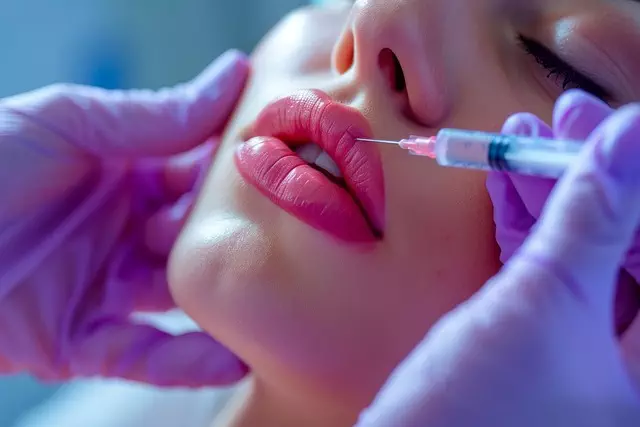Botox is an effective treatment for forehead lines, frown lines, and crow's feet caused by muscle contractions and aging. It relaxes overactive muscles, reduces dynamic wrinkles, and offers natural-looking results with minimal downtime. Safe when administered by a qualified professional, Botox boosts collagen production and improves skin elasticity. A quick, virtually painless procedure with minor side effects, it provides a non-invasive option for facial rejuvenation backed by clinical trials. Choosing the right dermatologist ensures expert guidance and personalized treatment tailored to individual concerns.
“Discover the power of Botox as a non-surgical solution for crow’s feet and facial rejuvenation. This comprehensive guide delves into the science behind Botox, its benefits for reducing forehead lines and frown lines, and the step-by-step procedure involved. Learn about potential risks, side effects, and recovery time while finding expert dermatologists for your treatment. Understand how Botox can transform your appearance and boost confidence.”
Understanding Crow's Feet and Their Causes

Crow’s feet are a common concern for many, characterized by fine lines and wrinkles that appear at the outer corners of the eyes. These telltale signs of aging are caused by repeated muscle contractions as we express emotions like smiling, frowning, or squinting. Over time, these muscles can become hyperactive, leading to the formation of dynamic lines that set in permanently, hence the term “crow’s feet.”
Understanding the causes is the first step towards addressing this aesthetic concern. Both genetic predisposition and environmental factors play a role. Exposure to UV rays, smoking, and frequent facial expressions contribute to skin damage and collagen breakdown, making Botox for forehead lines and frown lines a popular solution. By relaxing these overactive muscles, Botox can significantly reduce the appearance of crow’s feet, providing a more youthful and relaxed look.
What is Botox? A Comprehensive Overview

Botox, short for botulinum toxin, is a highly effective cosmetic procedure used to reduce the appearance of fine lines and wrinkles, most commonly targeting areas around the eyes known as crow’s feet and forehead lines. It works by blocking nerve signals that cause muscles to contract, thereby smoothing out skin in these targeted areas. This non-surgical treatment has gained immense popularity due to its ability to provide natural-looking results with minimal downtime.
The same Botox used for facial esthetics can also address frown lines between the eyebrows. By relaxing specific muscle groups, it prevents repeated contractions that lead to dynamic wrinkles. This not only improves one’s overall appearance but also boosts confidence and can make individuals feel more youthful and relaxed. As a safe and regulated cosmetic procedure, Botox continues to be a go-to option for those seeking to minimize the signs of aging discreetly and effectively.
The Science Behind Botox for Forehead Lines and Frown Lines

Botox is a highly effective treatment for both forehead lines and frown lines, offering a non-invasive approach to reducing the appearance of wrinkles. The science behind its success lies in its ability to temporarily paralyze specific muscles responsible for forming these lines when we frown or make facial expressions. By inhibiting these muscle contractions, Botox prevents the formation of dynamic wrinkles, providing a smoother and more youthful complexion.
When administered by a qualified medical professional, Botox safely and precisely weakens overactive muscles. This results in reduced wrinkling without impacting natural facial movements. Over time, as the effects of the treatment wear off (typically lasting 3-6 months), new collagen production can even enhance skin elasticity, contributing to long-lasting improvements in facial aesthetics.
Benefits of Using Botox for Non-Surgical Facial Rejuvenation

Botox has emerged as a popular, non-surgical option for facial rejuvenation, offering significant advantages in the fight against age-related wrinkles. When used to treat crow’s feet and frown lines, Botox provides a natural, subtle enhancement to one’s appearance without the need for invasive procedures. One of its key benefits is its ability to temporarily paralyze muscles responsible for causing wrinkles, leading to a smoother and more youthful complexion.
This treatment also offers convenience and minimal downtime, as it can be performed during a quick office visit. Unlike surgery, there are no incisions or extensive recovery periods involved. Additionally, Botox has been extensively studied, demonstrating its safety and efficacy in clinical trials, making it a trusted choice for those seeking to reduce forehead lines and frown lines without drastic measures.
The Procedure: Step-by-Step Guide to Botox Injections

Botox injections for crow’s feet involve a quick, virtually painless procedure. Typically, the process begins with a consultation where a dermatologist assesses your skin and determines the appropriate dosage. During the actual treatment, a fine needle is used to inject tiny amounts of Botox into the targeted muscle groups around the eyes, carefully avoiding nearby blood vessels and nerve endings. This procedure smooths out fine lines and wrinkles, offering a more youthful appearance.
The step-by-step process involves cleaning the skin, marking the injection sites using an aseptic technique, and then administering the Botox in calculated doses. The number of injections depends on the severity of crow’s feet. After the treatment, there may be minor redness or swelling, but these typically subside within a few hours to a day. It’s crucial to choose a qualified professional for this procedure to ensure safety and achieve optimal results, especially when addressing not just crow’s feet but also forehead lines and frown lines.
Potential Risks, Side Effects, and Recovery Time

While Botox is a safe and effective treatment for crow’s feet, it’s important to be aware of potential risks and side effects. The most common include temporary redness, swelling, or discomfort at the injection site. In rare cases, patients may experience headaches, nausea, or muscle weakness. When performed by a qualified professional, these side effects are usually mild and subside within a few days.
Recovery time for Botox treatments is swift. You can expect to see results within 24 to 72 hours, with the full effect reached after about a week. As for downtime, most people can resume their normal activities immediately after the procedure. However, it’s advisable to avoid strenuous exercise or sun exposure for a day or two to optimize healing and reduce the risk of bruising.
Finding the Right Dermatologist for Your Botox Treatment

When considering Botox for crow’s feet or other facial lines, such as forehead lines and frown lines, finding the right dermatologist is paramount. It’s crucial to seek a board-certified dermatologist with extensive experience in injectable treatments. This expert will not only have a deep understanding of anatomy and skin care but also be well-versed in the latest Botox techniques and product offerings.
During your initial consultation, make sure to discuss your concerns openly, including any specific areas you’d like treated. The dermatologist should take time to assess your skin, consider your medical history, and answer all your questions. A good doctor will tailor the treatment plan to your needs, ensuring natural-looking results that enhance your beauty without appearing artificial.
